“There’s a deer in my tanning booth at my hotel.”
Sergeant Justin Fowlie reflects on one of the many calls he’s gotten during his 20-year career in the Maine Warden Service, noting this one as bizarre but not quite out of the ordinary. “I said, ‘Excuse me, what did you say?’ And he says he’s got a deer in his tanning booth at the Trade Winds Inn in downtown Rockland.”
Rockland sits on the central coast of Maine on the edge of a harbor, and on this summer day, a doe swam across the water and climbed up the bank. Employees had left the back door open, “and the deer ran through the open door, went down the hallway, took a right, ran down that hallway, took a left, and then ran into an open tanning room. The staff didn’t know what to do so they shut the door and called us. I took a biologist, and sure enough, it was in there. It was kicking and thrashing. There was blood all over the walls. It tore that room up.”
After a tranquilizer from the biologist, the deer checked out of its room and into a nearby vet’s office. After a shot of penicillin, the deer was released deep in the woods to live out its days soaking up the sun’s natural rays.
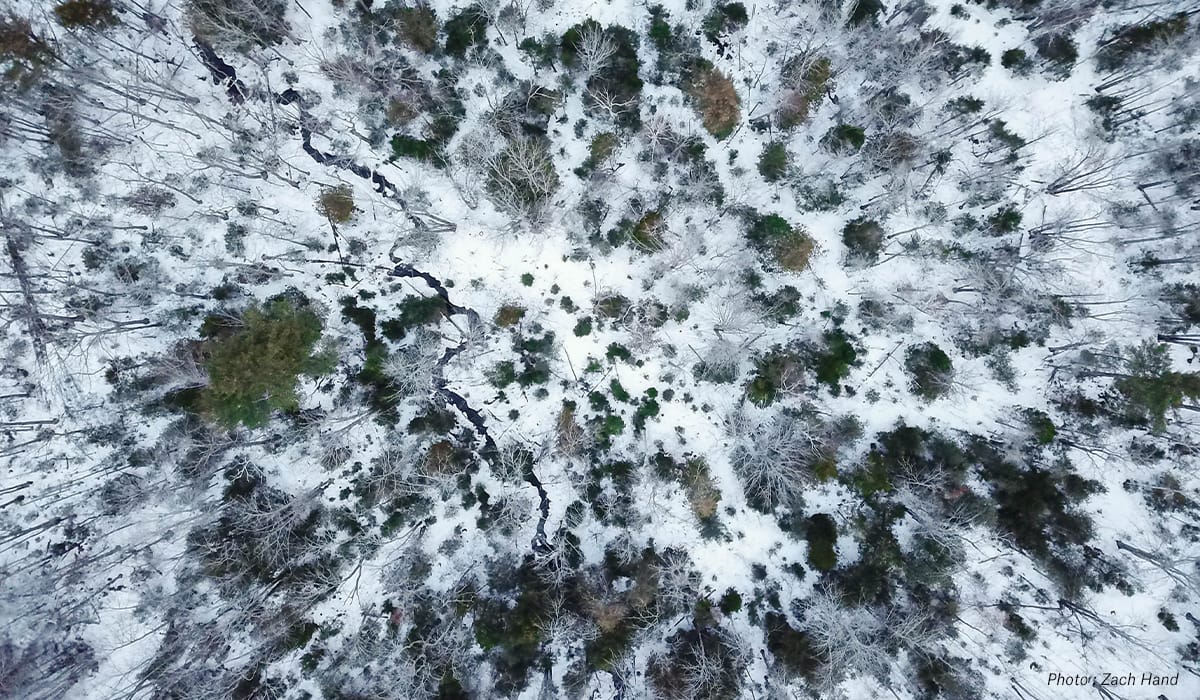
Fowlie, for those curious, was not one of the stars of “North Woods Law,” a reality show filmed about Maine’s game wardens, but he was promoted to replace show frontrunner, Sergeant Tim Spahr, after he retired from service. The pinnacle of Fowlie’s film career is as a backlit, from-behind silhouette in the show’s first season opening montage.
Fowlie’s actual career as a game warden is one rooted in the oldest conservation law enforcement agency in America, dating back to 1880. A decade after Maine became a state in 1820 it wrote up the first hunting season laws in the U.S. From September 1 to December 31 hunters could shoot deer and moose, with no bag limit. Between 1850 and 1870, out-of-state hunters were banned from Maine. Following the 1880 establishment of Maine’s game wardens, the state passed several laws governing hunting, including limiting each hunter to one moose, two caribou, and three deer, plus no hunting on Sundays (which still stands today).
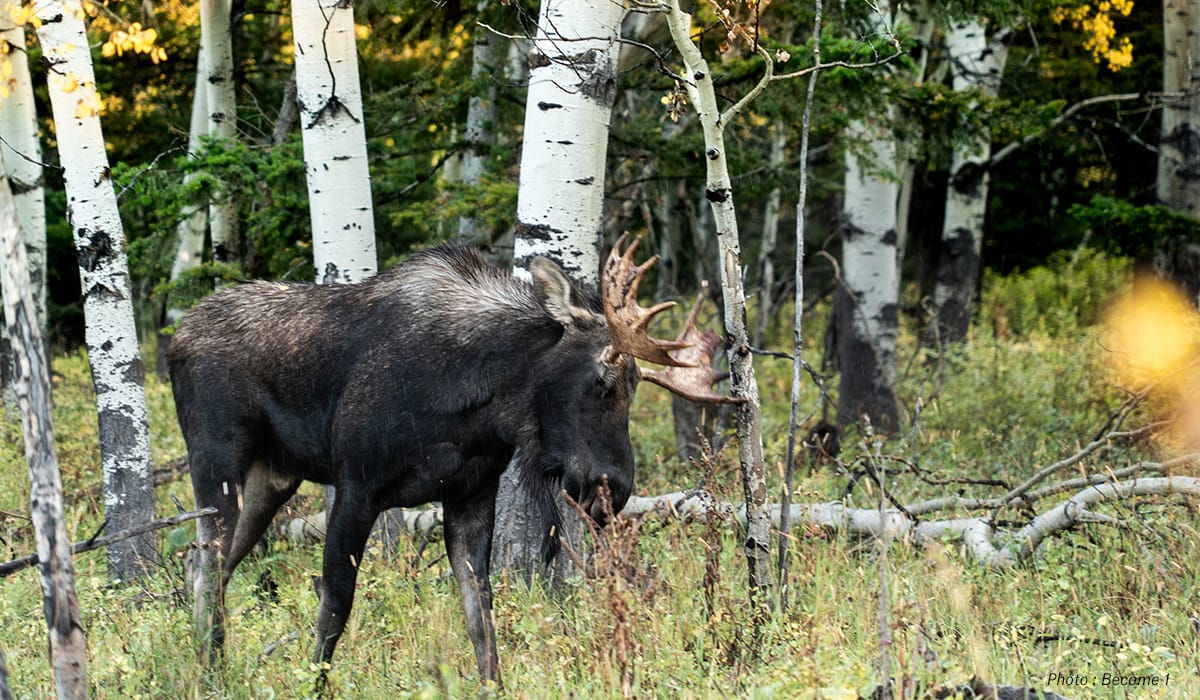
To be part of this highly regarded and historical Warden Service, one has to have the right mix of traits: integrity, preparedness, courage, and an immovable love for the outdoors.
“When I was 14 years old I decided that’s what I was going to be and I never looked back.“
“I grew up in a rural town in Maine and grew up hunting,” says Fowlie. “My dad was taking me hunting since I was 10, hunting deer and partridge. And I loved fishing. I’d bike down to the local brook and fish, even though we weren’t catching anything. We had a junker dirt bike to ride around, and when you fell off it the seat fell off too so you had to put it back on to keep riding. I built my own cedar strip canoe when I was 18 and fished out of it. I was just all in with the outdoors.
“My father also taught me to obey the rules, whether we disagreed with them or not. He was very strict about obeying the law, and I appreciate that about him. He taught the rules behind conservation, about how we limit what we take so others can enjoy the same thing.
“I always knew I wanted a job in the outdoors, and I wanted a job that was exciting. It was my dad who told me about the job of being a game warden, so when I was 14 years old I decided that’s what I was going to be and I never looked back.”
To be a game warden in Maine, and in most other states, an applicant has to have a college degree in a related field and commit to months of interviews, oral and written exams, and a physical fitness test before being one of the few selected to start training at a police academy. At the academy, wardens are training with future municipal police officers, state troopers, and other law enforcement.
“It’s a high-stress training environment,” says Fowlie. “It’s now 18 weeks of paramilitary training. We want to train our officers, including wardens, to be able to problem-solve and work through situations under intense stress, and the only way to do that is to create that kind of environment.”
Many wardens in the U.S. either work alongside other law enforcement agencies or are part of those agencies. In Maine, a game warden can back up officers and state troopers, and they can write tickets for non-game violations, including DUIs or speeding.
“We’ve had the same training as all other law enforcement, which is important in a rural state,” says Fowlie. “There’s a lot of towns that don’t have a local police force so they have to rely on county or state police. There might be one trooper or one lonely deputy way out somewhere and a warden is probably going to be his closest backup. We’re going to watch each other’s backs and help each other out.”
After those 18 weeks of intense training are up, game wardens start an additional 12 weeks of training relevant only to them. “Now we’re going to teach them how you catch someone night hunting for deer,” says Fowlie. “How do you set up proper surveillance? How should you work a smelt run? How do you work a brook? How do you safely operate a boat to stop another boat? That’s warden training.”
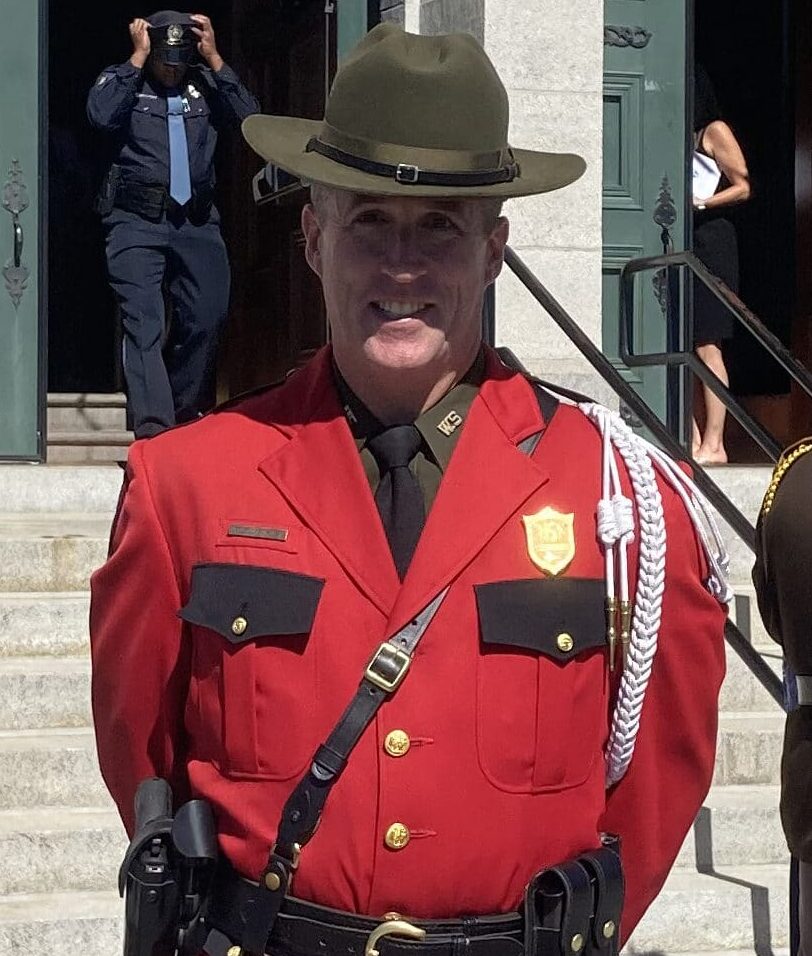
These training programs have produced a much different game warden today than when wardens got their start in medieval England. Both the term and the job came into existence not long after King Cnut the Great, ruler of England, Denmark, and Normandy from 1016 to 1035, enacted a forest law that made unauthorized hunting punishable by death. In need of people to patrol for poachers, protect the land, and organize the king’s hunts, the role of the warden was created.
By the 13th century, the word “warden” was coined as “one who guards,” derived from the Old North French, wardein. In Germany, the term for “warden” was jägermeister, meaning “hunt master.”
In the U.S., the role of the game warden deeply took root when states began enacting conservation and game laws. This was unfolding at the same time naturalist John Muir advocated for and helped found California’s Yosemite (est. 1890), Sequoia, and King’s Canyon parks. These new parks were under the protection of the state of California as wildlife preserves, which prompted the state to hire mountaineers to patrol them to prevent unauthorized hunting, fishing, and logging. By 1901, California employed 50 game wardens.
In a role with such a varied past—first as a guardian of royal privilege to protectors of public land and its resources—it’s no surprise that when game wardens are asked about what a “typical” day looks like, they answer with a chuckle.
“I don’t think there is an average day,” says Fowlie. “I wake up every day and expect the unexpected.”
“Some will try to play dumb a little bit and tell me, ‘Oh, I wasn’t really sure.’ Come on, you bought a license in the last five years. You know.”
While there might not be “average,” there are “busy” and “busier.” As the seasons change so do the types of recreation, so where wardens might spend their days on coastal or inland waters during the summers counting life jackets and looking for intoxicated daredevils, they’ll be riding snowmobiles looking for trespassers or fishing licenses on frozen lakes in winter.
And as hunting seasons come and go, they’ll be watching for bait piles, poached game, and again, more trespassers. Fishing is a year-round activity in most places, and it’s prone to year-round violations. One of the most common infractions any game warden will come across, any time of the year, is “fishing without,” meaning actively fishing without a valid license.
“Fishing without a license is quite common,” says Fowlie. “It’s intentional. They know they don’t have a license, but some of it is opportunistic. They have a rod there and they cast once or twice. Well, you’re fishing. Some will try to play dumb a little bit and tell me, ‘Oh, I wasn’t really sure.’ Come on, you bought a license in the last five years. You know. Or they say, ‘I have one, but I don’t have it on me, unfortunately.’ Really? Well fortunately we have cell service so just give me your name and I’ll call in and check. ‘Well, you know, come to think of it, I may not have bought one.’ Oh, okay.”
~~~
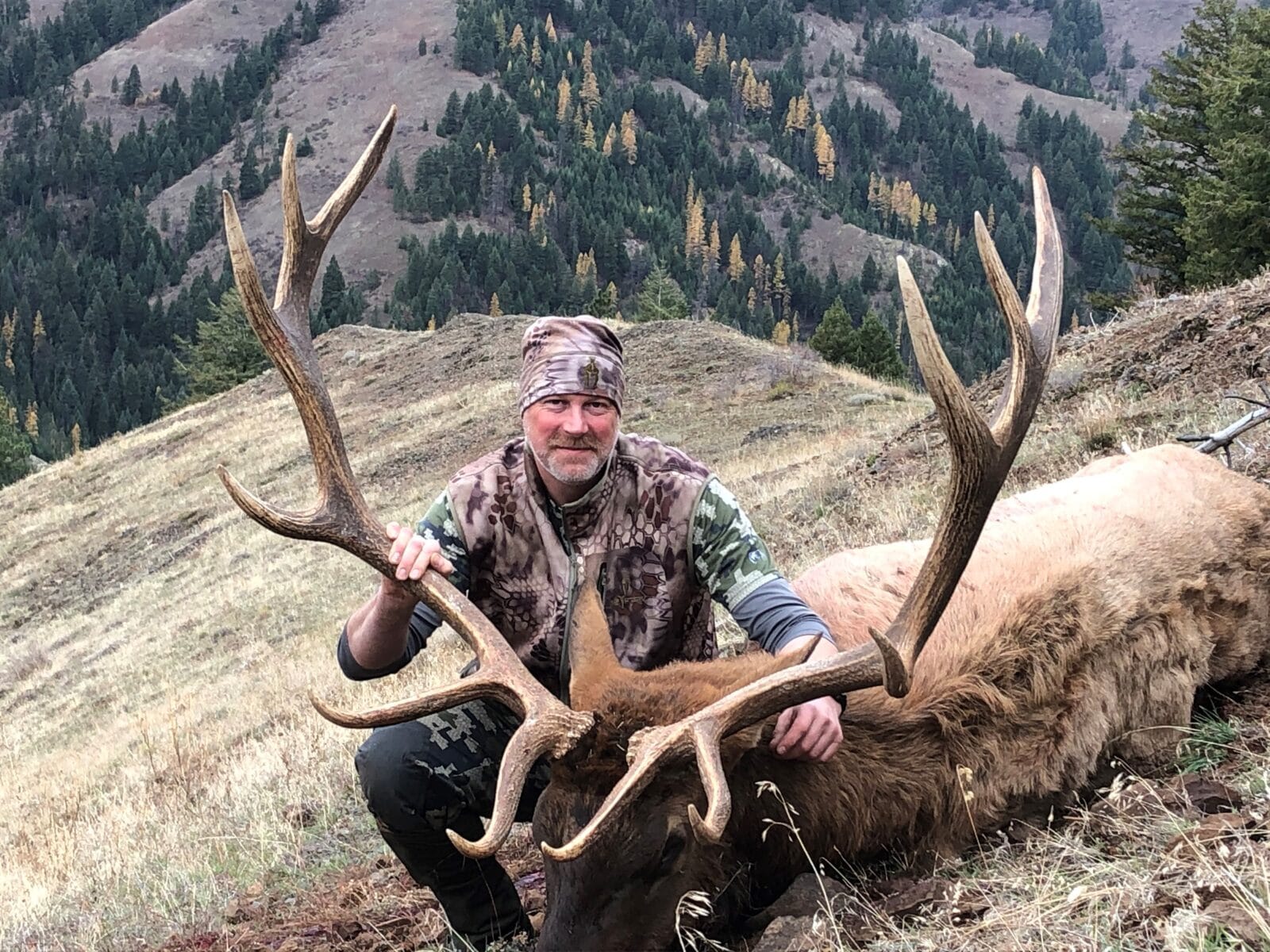
Wardens of The Beaver State
People play dumb in other states too. From the coast of Maine to the coast of Oregon, game wardens are on the front lines catching the licenseless and culling the few bad apples who feel entitled to take what they want out of the wild.
For Oregon State Police Lieutenant Vonn Schleicher of the Fish and Wildlife Division, a day’s work definitely includes busting people fishing without licenses, but it also bleeds into the night by guarding precious resources like steelhead, a threatened species in Oregon, as well as Coho and Chinook salmon, both of which are highly protected.
“By far our salmon species are the most regulated,” says Schleicher, “and it is often confusing because a lot of the regulations end up being changed throughout the year based upon return counts that are monitored by biologists. That’s why it’s very beneficial to the angler and the game warden to keep abreast of the emergency rules that come out.”
But sometimes people don’t care about the rules. Like Fowlie in Maine explained, people can be “opportunistic.” That’s exactly what Schleicher came across more than once in his 25-year career as a state trooper/game warden.
To clear up the nomenclature, in Oregon state troopers who are assigned to the Fish and Wildlife Division do the work of what one typically thinks a game warden does. According to Schleicher, Oregon and Alaska are the only two states in the U.S. that have “a true state police agency,” he says, though Michigan’s wardens are also state troopers, as we’ll learn more about shortly.
“What I enjoy about the Oregon State Police is that the career is never boring.”
“With Oregon and Alaska, you have one large agency called the State Police, and in Oregon, we have within that agency three primary divisions—the patrol division, fish and wildlife division, and our criminal division. The Fish and Wildlife Division is responsible for the protection of our natural resources across the state.
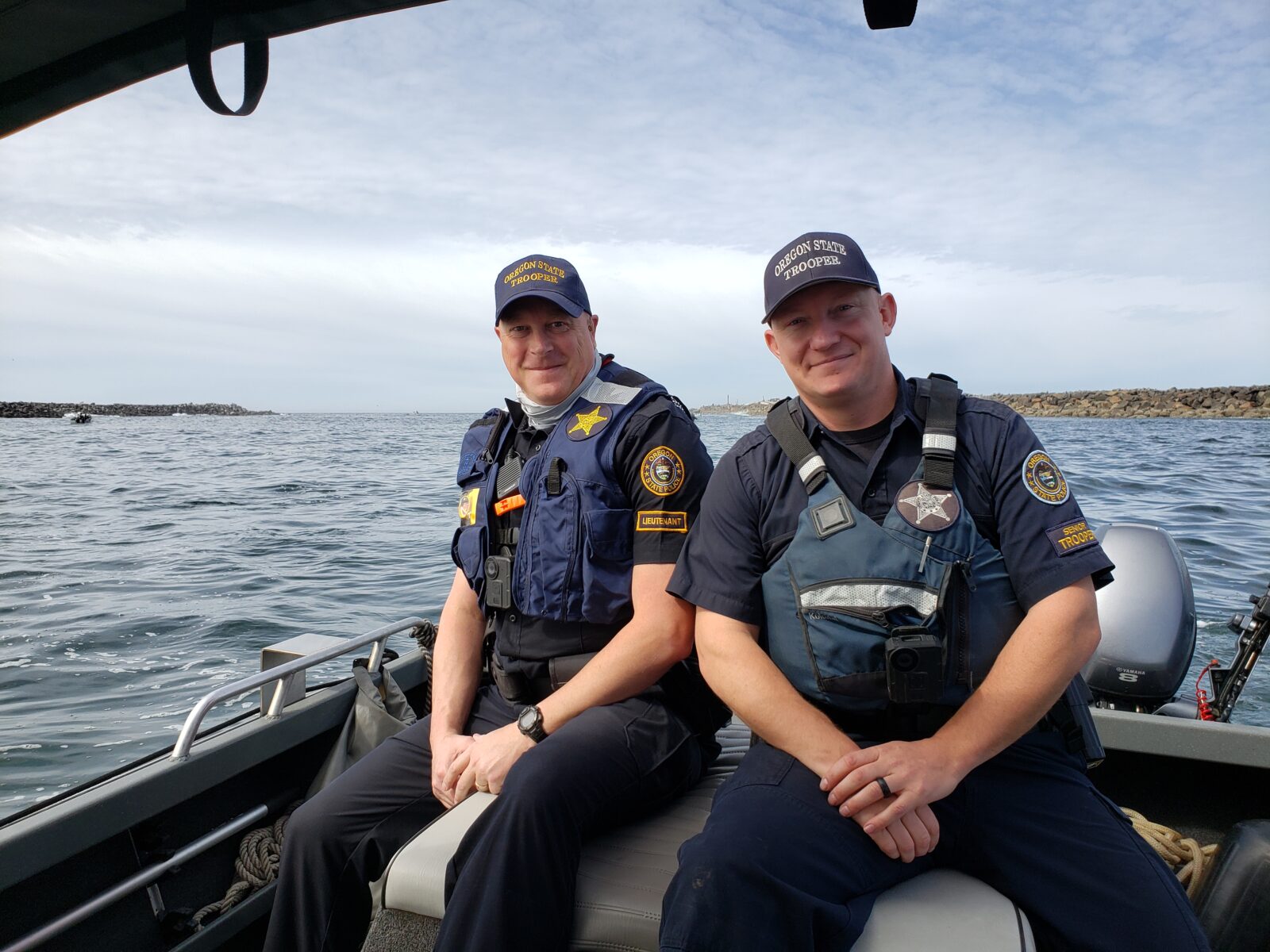
“What I enjoy about the Oregon State Police is that the career is never boring. We all go through the same training, and here in Oregon the natural resource laws, hunting and fishing specifically, are written in the manner that any police officer can enforce them. For a state trooper assigned to the fish and wildlife division, as I am, that becomes their priority. Oh, and we prefer to be called state troopers, not game wardens.”
In Schleicher’s Southwest Region, he has five different teams, each aligned with the different watersheds in the area. Each year, biologists and troopers get together and assess these impact areas and identify where they see the most violators and where wildlife is at the most risk of being poached or harmed. They map priorities for the year, be it an area for elk hunting, a specific salmon run, or angling for bull trout.
But priority number one for wardens is to catch bad people who want to do bad things in their district, which brings us back to Schleicher, steelhead, and sensors.
The Siuslaw River is a coastal waterway and its mouth runs through Florence, Oregon. Native steelhead use the Siuslaw in winter for spawning, but Oregon officials also infuse the run with hatchery-raised steelhead. Since there is no hatchery on this particular river system, all the hatchery fish are trucked in. After they are done spawning and begin to return to the Pacific Ocean, the hatchery fish must be pulled back out and returned to the hatchery.
To separate the wild and hatchery steelhead in the Siuslaw officials set up a fish weir. A fish weir is used to funnel steelhead into a trap. It is an ancient technique used for fishing. They were built from wood posts driven into the stream bed and placed in a “V” formation. Fish swimming downstream would funnel through the only opening in the weir and into a holding area that was walled off by more wood posts or stones, making it easy for people to net, spear, or hand-catch them.
For this particular fish trap on the Siuslaw, the holding area was fully encased with a locked hatch on the top, where the biologists could access the fish and sort them, letting the wild steelhead free.
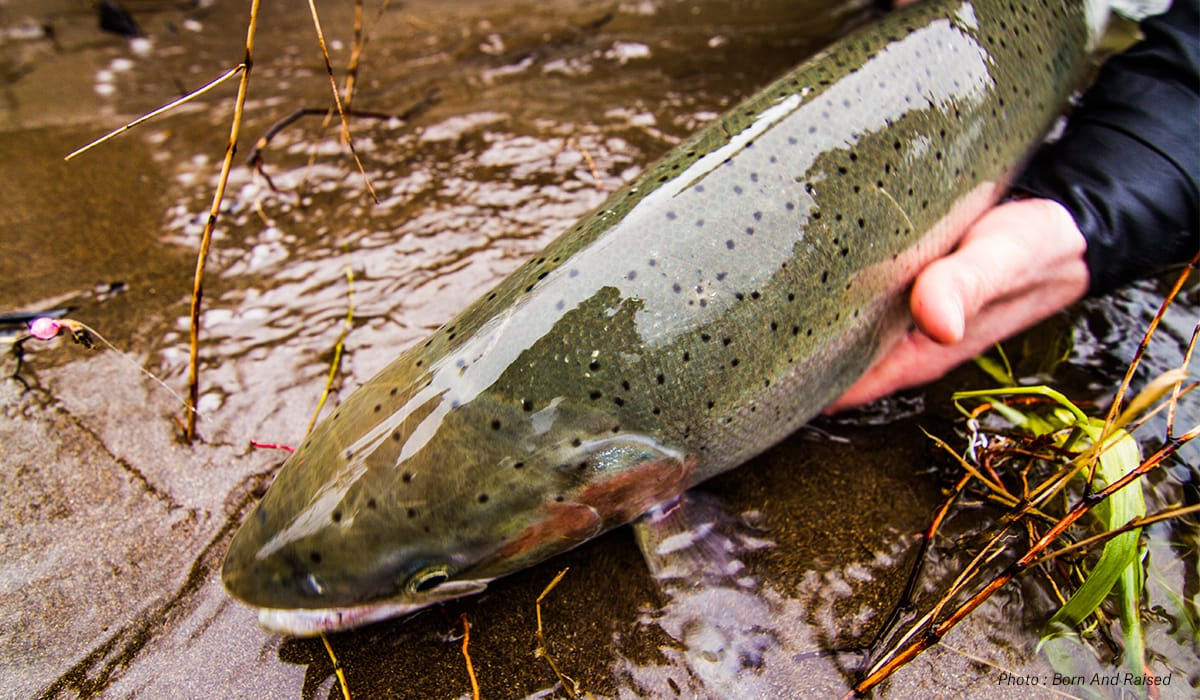
“This trap was out in the middle of nowhere,” says Schleicher. “For years the biologist and I were noticing evidence that people were breaking into the fish trap. The fear was that this trap held both wild and hatchery steelhead. So as the fish and wildlife trooper in the area, one year I vowed that I would safeguard this trap. Whoever was breaking into it was indiscriminate and would hurt our wild steelhead population.”
“So it’s me versus two in the dark.”
Schleicher assumed it was being hit at night. With a small team in place, the plan was to babysit the trap from dusk to dawn. With seismic sensors set up on the road system, he could be warned when vehicles were approaching. Everyone was equipped with night vision, but for two long weeks, no one came.
Then, on a night Schleicher was working the shift alone, the seismic sensor went off. “Here come two individuals tromping toward the fish trap,” says Schleicher. “I watched them through night vision goggles. The chain lock on the hatch allowed about a foot gap. One guy held the door open and the other squeezed himself through that foot opening down into the trap. His accomplice handed him a big net and they scooped up about eight steelhead. They then headed back up toward their truck.”
“So it’s me versus two in the dark,” says Schleicher. “I confronted them, shown my flashlight on them, and they dropped the net full of steelhead. They tried to run but I’m right there on them. I get them detained. Even though I was the only wildlife trooper on that night, the patrol troopers raced out to give me backup. When we went through their truck we found multiple firearms and spotlights. These two individuals were out for one thing, and that was to kill animals. Plus these two were convicted felons, so even having firearms was prohibited. All in all a great case, and one I’m proud of.”
Game wardens and state troopers aren’t always in the dark though, literally or figuratively, because they also rely on strong community connections, social media, and technology to catch the bad guys.
“I love maps. I cannot get enough maps.”
“Back when I started,” says Scheicher, “there wasn’t social media. Twenty-five years ago it was the local little mini-mart, just on the outside of town, that had a corkboard set up for hunters and fishermen to put up their Polaroid photos of them with their trophy animals. A good game warden stopped in there once a day to check out the trophy board to figure out who got what. Now we look at Facebook, Instagram, and the other social media sites to take a look and these prolific individuals, who I call genuine poachers, who can’t help themselves and they’ve got to share with somebody the big animal they got. They’ve got to brag about it. We look at social media a lot.
“But I still rely heavily on the friendships and connections I’ve made,” says Schleicher. “Word of mouth spreads quickly, and soon enough information comes back to game wardens with people asking, ‘Did you hear about that elk John Doe got last week?’
“We also rely a lot on maps,” says Schleicher. “With my background in forestry, I love maps. I cannot get enough maps. I’ll use every kind of computer map I can get.
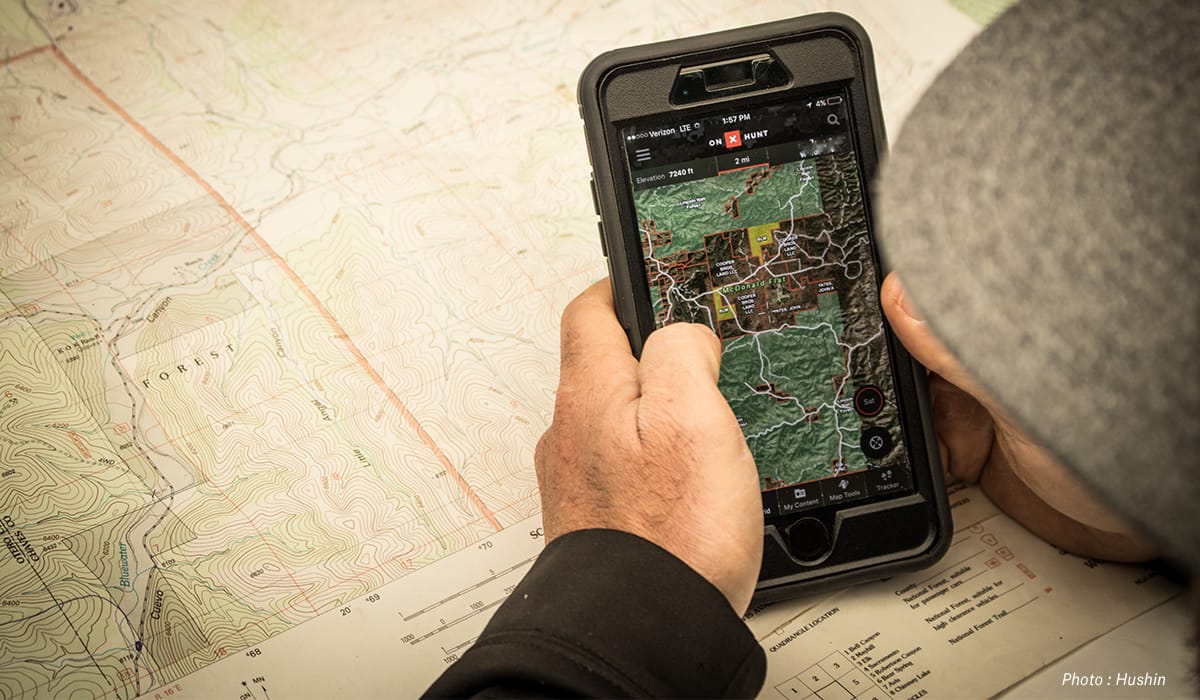
“Now when I talk with our contacts, or check in with a fisherman or hunter, and they tell me a story about what they saw, I often ask, ‘Hey, do you know the coordinates?’ We’ve found that our contacts have onX themselves and they’ve already saved the location. I can’t tell you how many times over the last five years people have shared with us their onX Waypoints. We take those Waypoints, plug them into our onX and we know exactly where they’re talking about.
“On the flip side, though, we also run into hunters who’ve entered onto private property. The landowner catches them and we get called,” says Schleicher. “When we get there we get about 15 minutes to figure out whether or not they’re telling the truth.
“They’ll swear to us they’re on public land. But now one of the questions we’ve learned to ask is, ‘We see that you’ve got your phone with you. Do you have a mapping system on your phone?’ They tell us they do. ‘Well, what do you have? We have onX. Did you take a look at onX before you came on here?’ And no they didn’t. Or if they say they did, we ask them to bring it up and show us where they’ve been. Then they see they were on private land. It helps us figure out who’s telling us the truth, who made an honest mistake, and who’s lying to us.”
~~~

A Conversation with Michigan’s Conservation Officers
Truth be told, two people you wouldn’t want to lie to are Michigan Conservation Officers Anna Cullen and Jackie Miskovich. Only three years into their career in Muskegon County, officers Cullen and Miskovich are one of two female-female partners in the state, out of 250 total officers, and the only pair working the west side of Michigan.
“There are about 15 female conservation officers in the state,” says Cullen. “Jackie and I went through the academy together and we make inclusivity a big part of our jobs. Now, more women come to us when they’re interested in this line of work.”
In Michigan, game wardens are called conservation officers (or C.O.s), and similar to Oregon they are also state troopers, meaning they have the same training and ability to enforce any state law, “but we choose to put an emphasis on wildlife and game laws,” Cullen says. “Besides, regular troopers aren’t out there checking fishing licenses, so if they’re not doing this work who will?”
“Now, I’d never take that bear away from this kid. Otherwise that kid would have a negative view of C.O.s forever.“
Both Cullen and Miskovich have joked that at times they feel like “conversation” officers because of the amount of education they do on a daily basis. But conversations do really go a long way with game wardens. Being reliant on the community’s watchful eyes is integral to their day-to-day successes.
“We cannot be everywhere,” says Cullen. “The community serves as our eyes. But also a lot of people don’t understand what we do, so part of our job is to educate them. Then they realize we’re on the same side. We both want our natural resources to be around longer than we will be.”
Sometimes, perhaps many times, that education is delivered without issuing a ticket. Already in the few years Cullen and Miskovich have been on the force, they’ve each seen some serious room-for-improvement behaviors from outdoors-people in their district.
“We had an incident where an eight-year-old shot a black bear,” says Cullen. “You work years to build up bonus points to draw this bear tag and he actually got the tag as a transfer from an adult, but his dad never tagged the bear after his son shot it.”
“Now, I’d never take that bear away from this kid,” says Cullen. “Otherwise that kid would have a negative view of C.O.s forever. I did, however, have very stern advice for the dad for not tagging it.”
Making a call like that is one part instinct and another part training. These game wardens, state troopers, and conservation officers face decisions like these routinely. Sometimes the call is clear; other times it is not.
Other calls, literal calls, are the things that define most of a warden’s day. Without people phoning in with what they’ve seen, or think they’ve seen, it would be hard to catch those making mischief.
“It’s important to me to keep calls and complaints anonymous,” says Cullen. “Someone rats on someone, right. They know for a fact that someone shot a deer, but they didn’t have a tag so they put someone else’s tag on it. Then you drive by the residence and clearly see six deer hanging in their garage. Those are good ones.”
Getting wardens to tell a good story about what they’ve experienced in the field is usually pretty easy, but those stories must be ones with endings in place. “So many of my great stories are still in the courts,” says Cullen, “so ask me in 10 years! Especially because last year we had a guy trying to destroy evidence.”
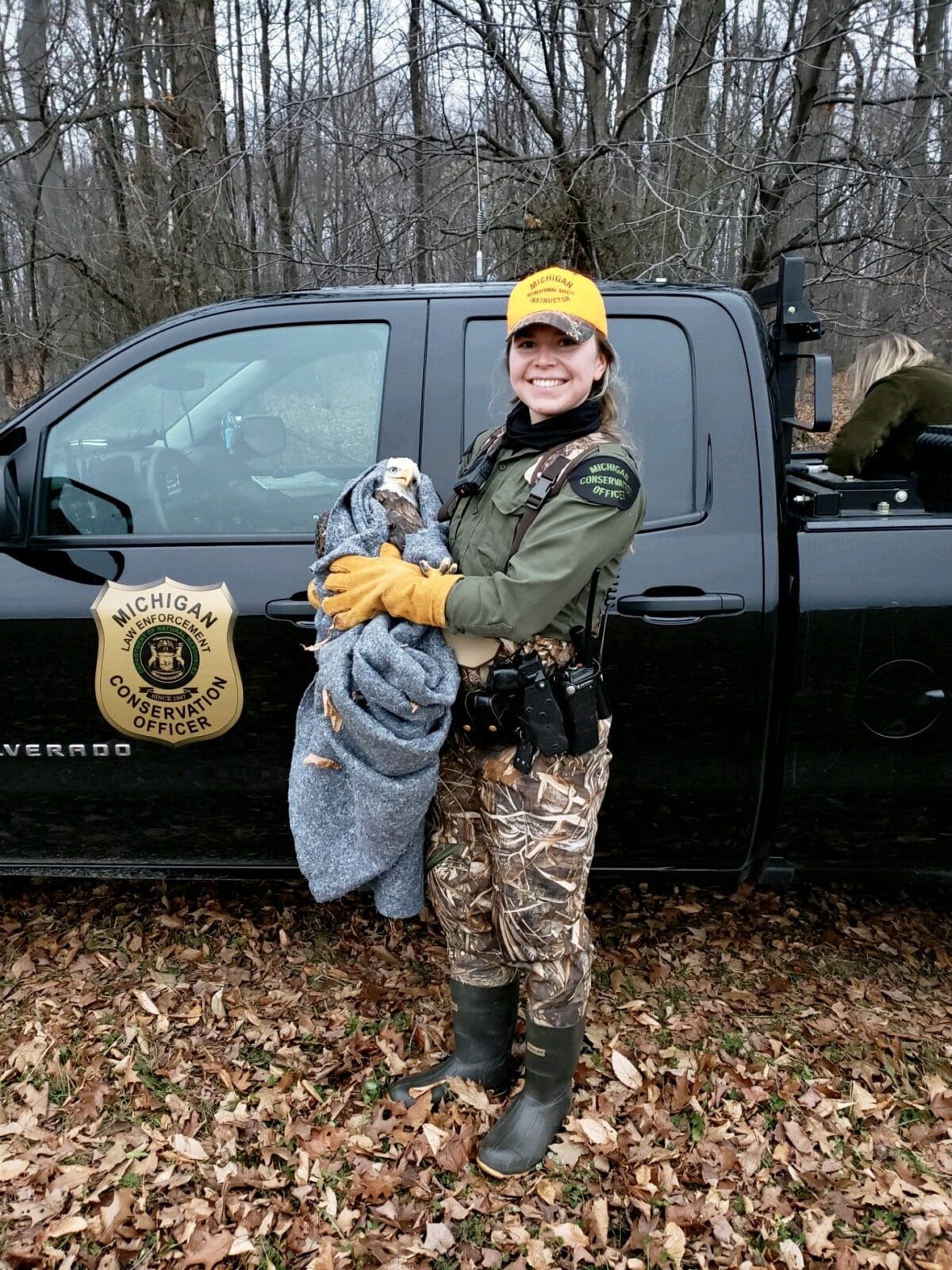
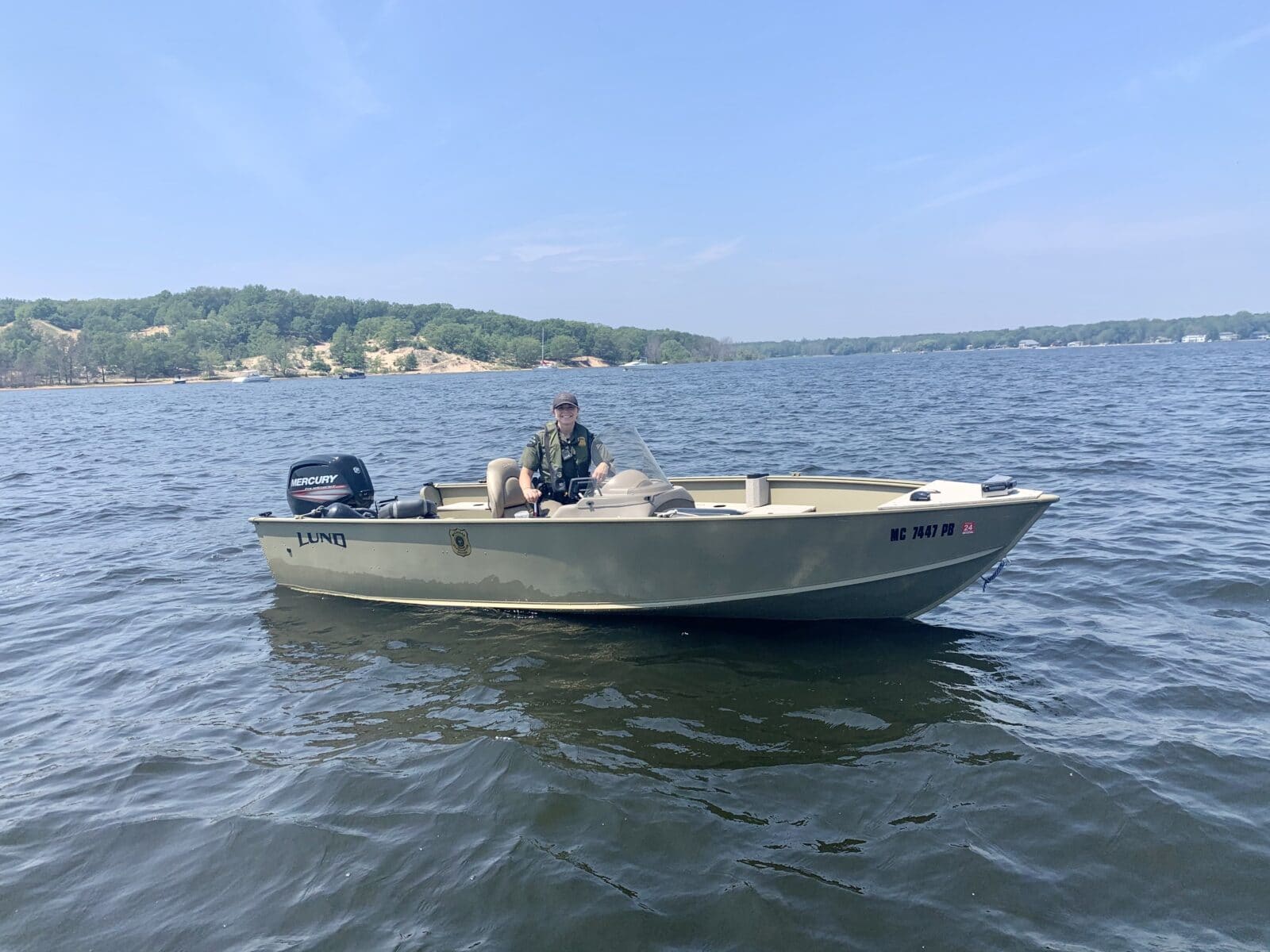
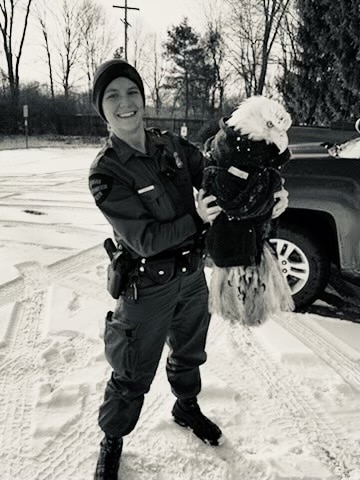
Time will tell how some of these cases will play out, but for Cullen’s partner, Jackie Miskovich, she’s already got stories to tell, and they started during her training.
“Trapping in Michigan is a dying sport.”
Nearly all warden training consists of “breakout schools,” in which trainees learn nearly everything there is to know about different forms of hunting, fishing, boating, ORVs, and other forms of recreation. Trainees essentially master as much as they can so they can better recognize good and bad, ethical and unethical, legal and illegal actions related to those activities.
When Miskovich spent a week learning the art of trapping, she was snared. Since then she’s dedicated herself to learning this pastime that has been slowly dwindling away and now she wants to carry the torch.
“Trapping in Michigan is a dying sport,” says Miskovich, “because it’s all older trappers who are trying to get out of it and maybe trying to hand it down to their grandkids, but with fur prices going down and this being an individual sport, they don’t want to just give up their good spots to anyone. And some people think trapping is a really bad thing, but I feel like it’s no different than going out and shooting a deer.”
With this training and personal dedication, Miskovich is now more attuned to recognizing areas where illegal trapping might occur, as well as what to look for to discover traps that are, by design, meant to be difficult to see.
“When Anna and I are out on the river looking for waterfowl hunters or maybe deer hunters doing a float hunt, we are looking for that, but I’m also looking for traps. I’m looking for places where muskrats might be running or beaver are running so I can come back to those areas, if the season isn’t open yet, because there might be a huge population in those spots but nobody’s supposed to be trapping in there. Once you get into it you start seeing things, and you might see there is a problem. There are certainly enforcement issues with trapping that need to be handled.”
While Miskovich’s partner is entirely on board and supportive of her passion for trapping, when asked if she has an interest in picking up this dying art, Cullen says, “It’s very time-consuming and I lack the patience.”
~~~
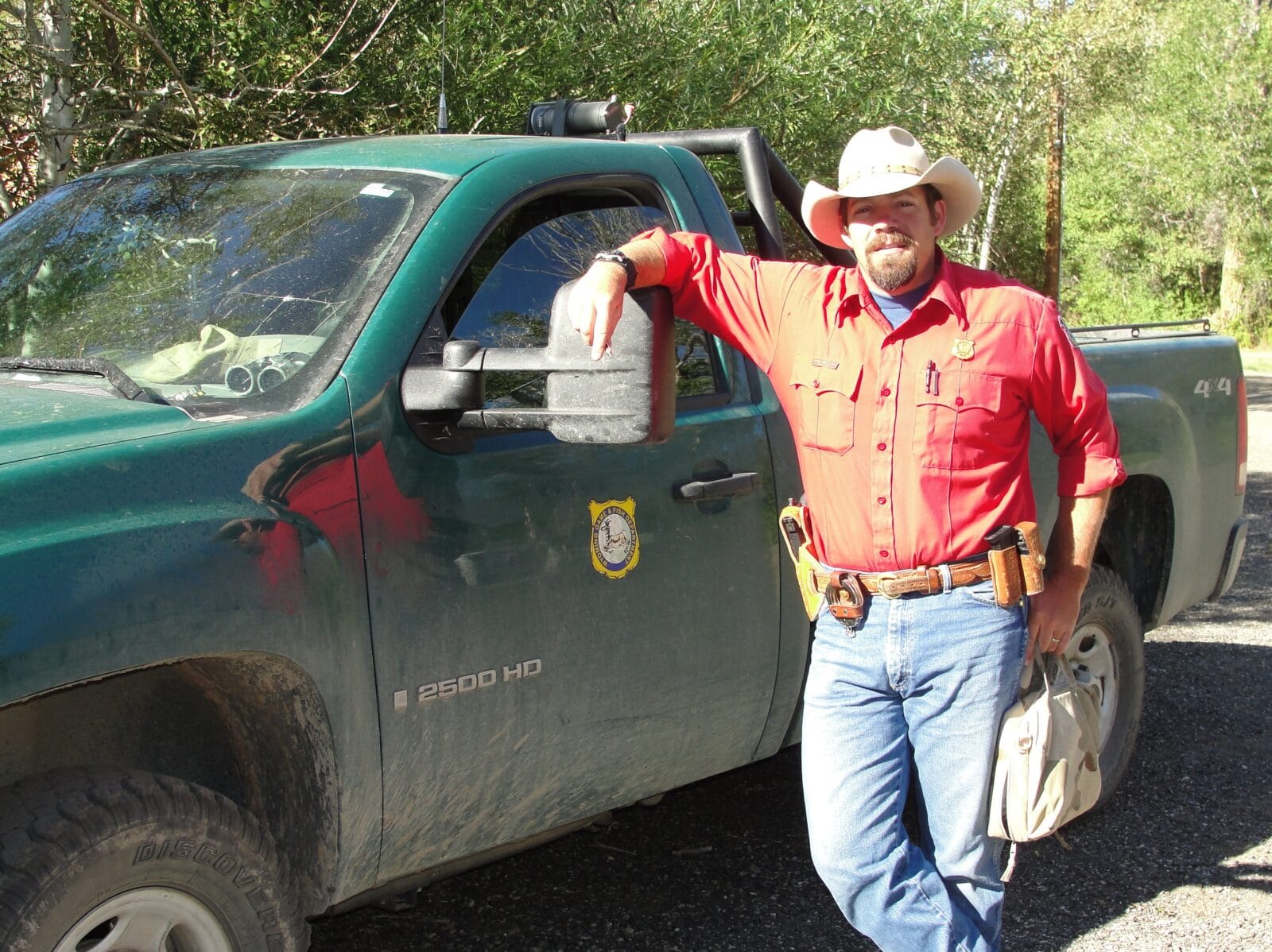
Red Shirts of Wyoming
It’s hard to feel trapped when your office covers 1,700 square miles of rugged Wyoming terrain, and for the red-shirted game wardens in the state, all 63 of them, patience has come with age.
“Our folks are a little older,” says Ryan Kenneda, who has worked as a Wyoming Game and Fish Department game warden for 17 years. “We have very high standards for the people we hire and we are all self-driven. We work hard and spend a lot of time— a lot of time—out in the field. We pretty much set our own hours, but with the expectation that we’re attending to those problems that arise no matter what time of day. You attend to the job and get ‘er done.”
One of the reasons Wyoming game wardens are on the older side is the requirement that every applicant has already completed a bachelor’s degree related to the field in some capacity. Plus, once wardens don the red shirt, it’s hard to take it off.
For as much as U.S. Forest Service employees are recognized for wearing green uniforms, Wyoming’s game wardens are known for their red shirts. “From day one we had these red shirts,” says Kenneda. “Way back when it was red shirts that people wore to be safe when hunting, but that’s now changed to blaze orange. That was part of the history of why we wear the red shirts, so we can be seen out in the country when we’re checking those hunters.”
This dress is more than lore: it’s official, according to the Wyoming Game and Fish Commission. Back in 1941 the official enforcement uniform was adopted, and it required wearing a western-style hat, boots, and a shirt with the antelope insignia on the left sleeve. Six years later, according to the Wyoming Game Wardens Association (WGWA), the Commission added to the uniform a “rust-colored shirt, black fore-in-hand[sic] necktie, Eisenhower jacket, and Guy Weadick western hat for the dress uniform.”
There’s a lot of acres in Wyoming to cover by boot, truck, and red shirts, and with hardly over 60 wardens it would seem that these officers could run themselves ragged just over license checks. Wyoming, however, isn’t just interested in finding poachers and pole-danglers. With highly trained, educated wardens on the force, there’s a lot of emphasis put on the biology side of things.
“Our thought is that if we hire a biologist and teach them to become a game warden it is a little bit easier than if we try to hire someone that is a full-time law enforcement officer and trying to teach them biological skills.”
“I can summarize our job as having three different aspects,” says Kenneda. “We do about 33% law enforcement. Another 33% is biological data-gathering or anything biology-related, and the last 33% is public contact, whether it’s with hunters or landowners. We’re very involved with our public. The public is a huge aspect of our job, and we’re very in tune with what’s going on in our communities, including how that relates to our wildlife.”
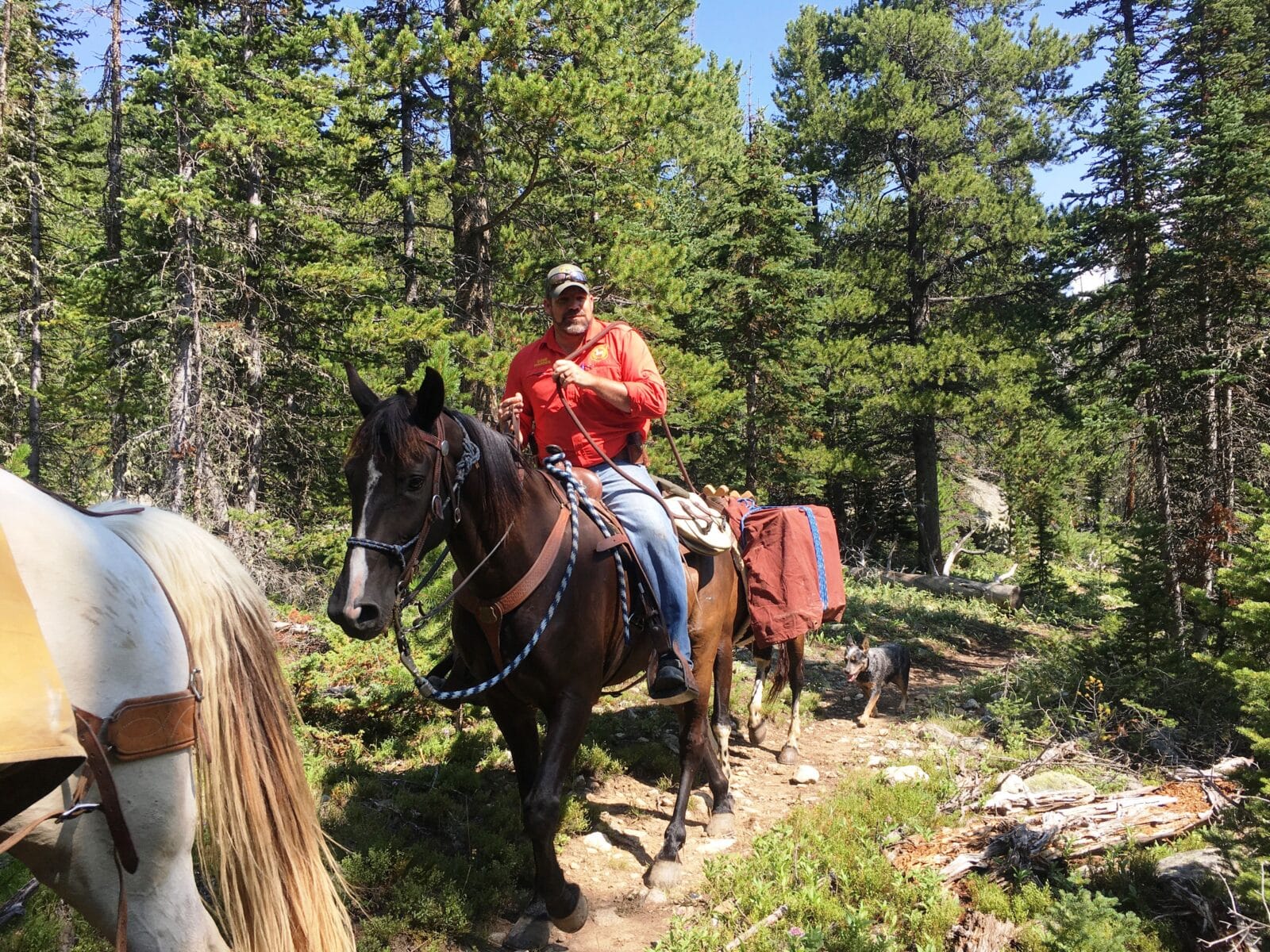
In fact, to be a game warden in Wyoming, the Game and Fish Department has historically favored the educated, inspired, and somewhat introverted biologist over the ones who purely wanted to pursue a law enforcement career.
“We tend as a department to hire introverts because those people are strong in the suit of being outdoors. It’s the same with biology. Our thought is that if we hire a biologist and teach them to become a game warden it is a little bit easier than if we try to hire someone that is a full-time law enforcement officer and trying to teach them biological skills.”
Kenneda, who holds a secondary education degree in biology, thinking he wanted to be a teacher, is based out of Sheridan, a town of 17,000 seated in a county of maybe 30,000. Like a lot of Wyoming, it’s a lot of intermixed private and public lands.
Wyoming, even with its 18 million acres of public land and its 43 million acres of federal mineral estate lands, is still the record-holder of inaccessible public lands that are surrounded by private land. In a joint study by onX and the Theodore Roosevelt Conservation Partnership, Wyoming was found to hold one-third of the 9.5 million acres of public land in the West that’s still inaccessible.
What this doubles down on is the importance of game wardens having solid working partnerships with landowners and being vigilant about trespassers. “When I was working in Elk Mountain,” says Kenneda, “the violation that was most common was trespassing. Throughout the state, though, the most common violation is ‘failure to tag.’ I still see some trespassing around Sheridan, even though I have more private land here that I watch over. It’s just larger chunks around here, not as much checkerboard. But that’s where mapping programs come in handy, knowing where you can and cannot be.”
If Kenneda has noticed one thing over his long career as a game warden, it’s the sense that people really do want to be engaged, informed, legal, and helpful.
“Every year we get phone calls,” he says, “frequently about the elk population, or the wildlife population, their habits and movement, their winter ranges, summer ranges, transition ranges, but at the same time they’re also inquiring about the laws and regulations to get informed about hunting. I do think the public is engaged more and more. The hunting community, the fishing community, they are involved and educated, as well as just being good conservationists.”
~~~
It’s unlikely many more deer will show up for unannounced tanning sessions and the father in Michigan will probably help his son tag every animal he ever shoots from now on. But who knows if trapping will survive another hundred years? And if we keep losing access to public lands it may become more tempting for some to trespass where they shouldn’t, yet certainly dedicated poachers will continue finding ways to exploit our natural resources and brag about doing so.
For these reasons and countless others, we are thankful for the men and women who take the calls, sit up all night in the woods, and bust bad people. We are also humbled to be among the tools thousands of wardens rely on to do their jobs. Keep up the good work, and keep expecting the unexpected.